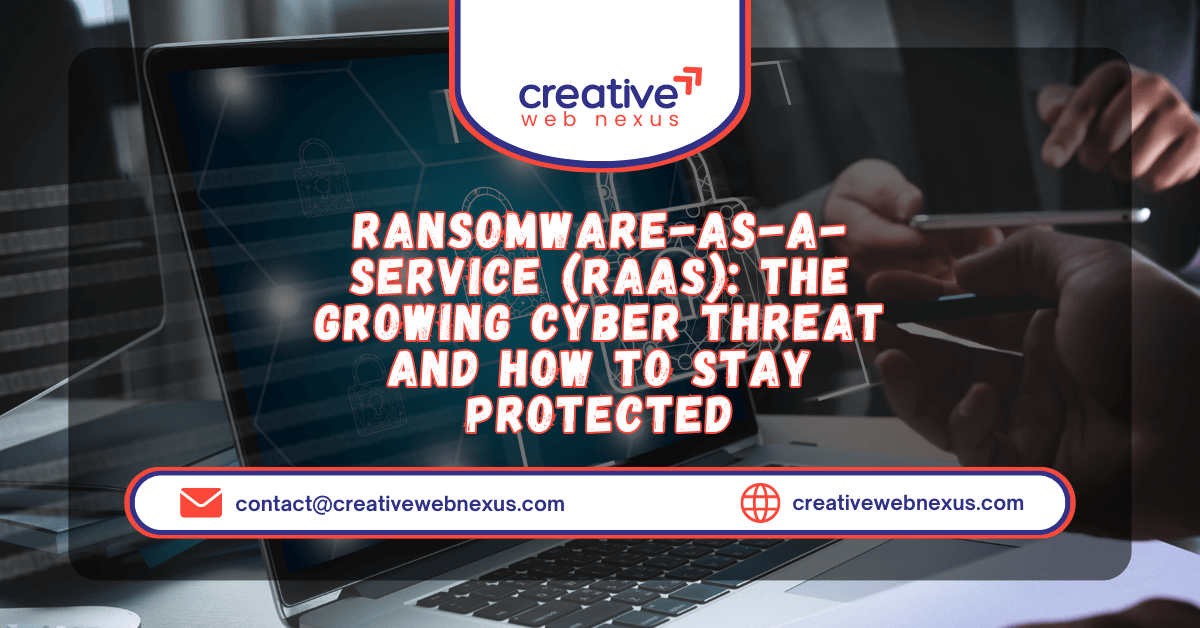Introduction
The digital landscape has become a battleground, and Ransomware-as-a-Service (RaaS) is the weapon of choice for many cybercriminals. This insidious cyberthreat, a rapidly growing problem, is not just about individual hackers anymore; it’s a sophisticated business model that democratizes access to malicious tools, enabling even those with limited technical skills to launch devastating attacks. This article will provide insights into the intricacies of RaaS, from its inception to its future trends, offering specialized tips and in-depth guides on how to prevent, mitigate, and respond to these attacks.
The traditional image of a lone hacker hunched over a keyboard, meticulously crafting malware, is increasingly outdated. RaaS has transformed the cybercrime ecosystem, allowing cybercriminals to lease ransomware tools and infrastructure from developers, effectively outsourcing the most complex and resource-intensive aspects of their attacks. This model has led to a surge in incidents, broadening the range of potential victims and increasing the frequency of attacks.
Understanding the inner workings of RaaS, including the roles of affiliates and operators, the attack techniques employed, and the financial motivations driving this cyberthreat, is crucial for organizations and individuals alike. This comprehensive guide aims to equip you with the knowledge and strategies necessary to defend against RaaS attacks, protect your data, and maintain your operational integrity.
Understanding RaaS: The Business Model of Cybercrime
What is Ransomware-as-a-Service?
Ransomware-as-a-Service (RaaS) is a subscription-based model, where cybercriminals can lease ransomware tools to launch attacks. The developers create and maintain the malware, while the affiliates handle distributing, encrypting, and demanding payments in cryptocurrencies. This democratizes access to sophisticated ransomware, even for those without technical expertise. The model also provides customer support and updates. It is, essentially, the SaaS for cybercrime.
The core of RaaS is the division of labor. The creators of the ransomware are the providers or operators, responsible for the development, maintenance, and updates of the malicious software. They ensure the code is sophisticated enough to detect and bypass security measures, and that the decryption process is reliable, although that’s never a guarantee. These developers may never be involved in an attack themselves, instead operating like a legitimate software company, providing support and updates to their “customers” (the affiliates).
Ransomware is malware that encrypts a victim’s data, rendering it inaccessible until a ransom is paid for the decryption key. The ransom is often demanded in cryptocurrencies, such as bitcoin, to maintain anonymity. RaaS makes this more readily available to the public. The entire ecosystem is designed to bypass security measures.
How RaaS Works: The Role of Affiliates and Operators
The RaaS model hinges on a symbiotic relationship between operators and affiliates. The operators focus on the development, maintenance, and updates of the ransomware, ensuring it remains sophisticated and difficult to detect. This involves writing the code, creating exploit kits, and providing customer support to affiliates, and the infrastructure that supports it. They may also offer customized versions of the ransomware for targeted attacks.
Affiliates, on the other hand, are responsible for distributing the ransomware and targeting organizations. They employ various attack techniques, including phishing email attachments, exploiting software vulnerabilities, and leveraging remote desktop protocols (RDPs). Once inside a network, they may attempt to spread laterally, exfiltrate sensitive data, and ultimately encrypt the victim’s files. The goal is to cause as much operational disruption as possible, thereby increasing the likelihood of a ransom being paid.
The revenue generated from ransom payments is typically split between the operators and affiliates, with the operators often taking a larger share to account for their development and maintenance costs. This subscription-based model encourages innovation and proliferation, as operators are incentivized to create more sophisticated ransomware and affiliates are driven to find new and effective ways to distribute it. This makes it easier for cybercriminals to conduct cyberattacks.
Key RaaS Providers and Notable Ransomware Groups
Several RaaS providers and ransomware groups have emerged as prominent players in the cyberthreat landscape. REvil (also known as Sodinokibi) gained notoriety for its large-scale attacks, including the REvil attack on Kaseya in 2021, which had a massive impact. Ryuk, often attributed to the Russian-speaking group Wizard Spider, has been associated with numerous targeted attacks against high-value targets, such as corporations and hospitals.
DarkSide, responsible for the Colonial Pipeline attack, demonstrated the potential for ransomware to cause significant disruptions to critical infrastructure. The Colonial Pipeline attack crippled the East Coast’s fuel supply. Other notable groups include LockBit, known for its sophisticated ransomware and aggressive double extortion tactics, and BlackBasta, a relatively new player that has quickly gained prominence. The key players steal confidential data and publish it if the ransom is not paid.
Identifying and tracking these groups is essential for developing effective defense strategies. Cybersecurity organizations and law enforcement agencies actively monitor these groups, sharing threat intelligence and working to disrupt their operations. The constant evolution of these groups underscores the need for a proactive and adaptable approach to cybersecurity. Also, the U.S. Department of Justice took down the LockBit gang and operation in January 2024 and seized their servers.
Insights: The Rise and Evolution of RaaS
Historical Context and Early Ransomware Variants
The roots of ransomware can be traced back to the late 1980s, with the emergence of the AIDS Trojan. This early variant, while rudimentary by today’s standards, demonstrated the basic principle of encrypting a victim’s data and demanding payment for its decryption. However, it was largely ineffective due to its weak encryption and easy decryption process. The rise of the AIDS Trojan was the beginning of ransomware.
The inception of modern ransomware can be attributed to the advancements in encryption techniques and the increasing accessibility of the internet. Early variants like CryptoLocker, which emerged in 2013, utilized stronger encryption algorithms, such as RSA-2048 and AES-256, making decryption without the key practically impossible. These early attacks often relied on social engineering and phishing tactics to infect victims’ computers.
The shift towards RaaS marked a significant turning point. Instead of individual hackers developing and deploying their own ransomware, developers began offering their malicious software as a service, allowing affiliates to lease the tools and launch attacks without needing advanced technical skills. This democratized access to ransomware, leading to a surge in incidents and the proliferation of new variants.
The Shift from Individual Hackers to Organized Cybercrime
The evolution of ransomware from individual hackers to organized cybercrime represents a fundamental shift in the cyberthreat landscape. In the early days, ransomware was often the work of lone wolves, motivated by financial gain or malicious intent. These individuals typically possessed the technical skills to develop and deploy their own malware, but their reach and resources were limited. Organized groups were able to use their technical expertise and knowledge of vulnerabilities to their advantage.
The rise of RaaS facilitated this transition to organized cybercrime. By outsourcing the development and maintenance of ransomware, cybercriminals could focus on distributing the malware and targeting organizations. This division of labor allowed for greater efficiency and scalability, leading to a surge in attacks. It also enabled cybercriminals to specialize in different aspects of the attack chain, such as social engineering, exploiting vulnerabilities, or negotiation.
The shift towards organized cybercrime has also led to the emergence of sophisticated ransomware groups with significant resources and capabilities. These groups often operate like legitimate businesses, with dedicated teams for development, distribution, negotiation, and customer support. They may also invest in advanced attack techniques, such as double extortion, to increase the likelihood of a ransom being paid.
Emerging Trends and Predictions for RaaS Growth
Several emerging trends are shaping the future of RaaS and driving its continued growth. One key trend is the increasing sophistication of ransomware variants. Developers are constantly innovating, creating malware that is more difficult to detect, more resilient to decryption, and capable of causing greater damage. This includes the use of advanced encryption algorithms, multi-stage attacks, and techniques to evade antivirus software and other security measures.
Another significant trend is the growing threats to cloud and virtualized environments. As more organizations migrate their data and applications to the cloud, they become increasingly vulnerable to ransomware attacks targeting these platforms. Cybercriminals are developing new attack techniques specifically designed to exploit vulnerabilities in cloud infrastructure and encrypt data stored in virtualized servers.
Finally, collaboration between cybersecurity firms and law enforcement is becoming increasingly important in the fight against RaaS. By sharing threat intelligence, coordinating defense strategies, and working together to disrupt ransomware operations, these organizations can significantly reduce the impact of RaaS attacks. This collaboration is crucial for staying ahead of the evolving cyberthreat and protecting organizations and individuals from financial losses, operational disruptions, and reputation damage.
Pros & Cons of RaaS (From a Cybercriminal & Security Perspective)
Why Cybercriminals Use RaaS – Benefits of the Model
The RaaS model offers numerous benefits to cybercriminals, making it an attractive option for those seeking to profit from ransomware attacks. One of the primary advantages is the low barrier to entry. RaaS democratizes access to sophisticated malware, allowing individuals with limited technical expertise to launch attacks. This significantly expands the pool of potential cybercriminals, leading to a surge in incidents.
RaaS also allows cybercriminals to outsource the most complex and resource-intensive aspects of their attacks, such as development, maintenance, and customer support. This frees up affiliates to focus on distributing the ransomware and targeting organizations, increasing their efficiency and reach. RaaS also gives cybercriminals anonymity.
Furthermore, RaaS provides cybercriminals with a reliable revenue stream. Operators and affiliates typically share the revenue generated from ransom payments, with the operators taking a larger share to account for their development and maintenance costs. This incentivizes innovation and proliferation, as operators are driven to create more sophisticated ransomware and affiliates are motivated to find new and effective ways to distribute it. Cybercriminals also don’t need to worry about being traced.
The Challenges and Risks for RaaS Operators
While the RaaS model offers numerous benefits to cybercriminals, it also presents several challenges and risks for RaaS operators. One of the primary challenges is maintaining the sophistication and effectiveness of their ransomware. Cybersecurity firms and law enforcement agencies are constantly developing new defense strategies and tools to detect and prevent ransomware attacks. Operators must continuously innovate and update their malware to stay ahead of these defenses.
Another significant risk is the potential for law enforcement intervention. Law enforcement agencies are increasingly targeting RaaS operators, working to identify and disrupt their operations. This can involve seizing servers, arresting operators, and recovering ransom payments. The risk of being caught and prosecuted is a significant deterrent for many cybercriminals.
RaaS operators also face the challenge of managing their affiliates. Affiliates can be unreliable, incompetent, or even turn on the operators. Operators must carefully vet their affiliates and monitor their activity to ensure they are not engaging in risky or unethical behavior. RaaS operators also have to worry about their reputation and trust from customers.
The Impact on Organizations and Global Cybersecurity
The impact of RaaS on organizations and global cybersecurity is profound and far-reaching. RaaS attacks can cause significant financial losses, operational disruptions, and reputation damage. Organizations may be forced to shut down their operations for extended periods, resulting in lost revenue, reduced productivity, and damaged customer relationships. The Colonial Pipeline attack is a prime example of this impact.
RaaS also poses a significant threat to critical infrastructure, such as power grids, hospitals, and transportation systems. Attacks on these systems can have devastating consequences, potentially disrupting essential services and endangering lives. The proliferation of RaaS has made it easier for cybercriminals to launch these attacks, increasing the risk to global cybersecurity.
Addressing the threat of RaaS requires a multi-layered approach involving organizations, cybersecurity firms, law enforcement agencies, and governments. This includes implementing robust cybersecurity measures, sharing threat intelligence, disrupting ransomware operations, and holding cybercriminals accountable for their actions. Only through a concerted and coordinated effort can we effectively mitigate the impact of RaaS and protect organizations and global cybersecurity.
Real-World Examples of RaaS Attacks
Colonial Pipeline Attack (DarkSide)
The Colonial Pipeline attack in May 2021 serves as a stark reminder of the devastating consequences of RaaS attacks. The attack, carried out by the DarkSide group, crippled the largest fuel pipeline in the United States, disrupting the supply of gasoline, diesel, and jet fuel to the East Coast. The attack caused widespread panic buying, fuel shortages, and soaring gas prices.
DarkSide, a known RaaS provider, extorted Colonial Pipeline for 5 million USD in cryptocurrency. The attack highlighted the vulnerability of critical infrastructure to ransomware and the potential for cybercriminals to cause significant disruptions to the economy and society. In response, Colonial Pipeline paid the ransom, but authorities were later able to recover a portion of the payment.
The Colonial Pipeline attack led to increased scrutiny of cybersecurity practices in the critical infrastructure sector. It also prompted the government to take steps to improve cybersecurity and defense capabilities. The attack served as a wake-up call for organizations and governments around the world, underscoring the need to prioritize cybersecurity and protect critical infrastructure from cyberthreats.
REvil, Ryuk, and Other Major Ransomware Groups
REvil (also known as Sodinokibi) has been linked to numerous high-profile attacks, including the Kaseya supply chain attack in 2021. This attack compromised Kaseya’s VSA software, which is used by managed service providers (MSPs) to manage their customers’ IT systems. The attack spread to thousands of organizations, encrypting their data and demanding ransom payments. REvil’s attacks resulted in millions of dollars in financial losses and significant operational disruptions. The attacks were multi-stage and sophisticated.
Ryuk, often associated with the Russian-speaking group Wizard Spider, has been responsible for a series of targeted attacks against hospitals, corporations, and other high-value targets. Ryuk attacks typically involve a multi-stage process, starting with a phishing email or other attack vector to gain initial access to a network. Once inside, the attackers move laterally, exfiltrate sensitive data, and ultimately encrypt the victim’s files.
Other major ransomware groups include LockBit, BlackBasta, and DarkSide, each with its own unique tactics, techniques, and procedures (TTPs). Tracking these groups and understanding their TTPs is essential for developing effective defense strategies. Cybersecurity firms and law enforcement agencies actively monitor these groups, sharing threat intelligence and working to disrupt their operations. This sharing of cyberthreat intelligence helps organizations to better protect themselves.
Financial Losses, Operational Disruptions, and Reputation Damage
The financial losses associated with RaaS attacks can be substantial. Organizations may incur costs related to ransom payments, data recovery, system restoration, legal fees, and regulatory fines. In addition, attacks can cause significant operational disruptions, forcing organizations to shut down their operations for extended periods. This can result in lost revenue, reduced productivity, and damaged customer relationships. The financial losses include the ransom paid to cybercriminals.
RaaS attacks can also inflict significant reputation damage on organizations. A data breach or ransomware attack can erode customer trust, damage brand image, and lead to a loss of business. Organizations may struggle to recover from the reputational blow, particularly if they are perceived as having been negligent in their cybersecurity practices. The cost of reputation damage can be long-term.
The combination of financial losses, operational disruptions, and reputation damage can have a devastating impact on organizations, particularly small and medium-sized businesses. RaaS attacks can cripple operations, jeopardize financial stability, and even force organizations to close their doors. The Colonial Pipeline and Kaseya attacks caused massive losses in revenue and reputation. For organizations, a cybersecurity plan is essential.
Advanced How-Tos: RaaS Attack Techniques and Defense Mechanisms
Social Engineering and Phishing Attacks
Social engineering and phishing attacks are among the most common and effective attack techniques used by RaaS affiliates. These attacks rely on manipulating human psychology to deceive victims into revealing sensitive information, such as usernames, passwords, and credit card numbers. Phishing emails often masquerade as legitimate communications from trusted sources, such as banks, government agencies, or popular online services.
Phishing emails may contain malicious attachments or links that, when clicked, download compromised files or redirect victims to fake websites designed to steal their credentials. Attackers may also use social engineering tactics to trick victims into providing access to their computers or networks. This is a sophisticated attack technique that has a high success rate.
Defending against social engineering and phishing attacks requires a multi-pronged approach. Organizations should implement security awareness training for their employees, educating them about the dangers of phishing and social engineering and teaching them how to identify and avoid these attacks. Organizations should also implement technical controls, such as email filtering, antivirus software, and multi-factor authentication, to prevent phishing emails from reaching employees and to protect credentials from being stolen. Cybersecurity practices are essential.
Exploiting Software Vulnerabilities and Remote Desktop Protocols (RDPs)
Exploiting software vulnerabilities is another common attack technique used by RaaS affiliates. Software vulnerabilities are weaknesses in code that can be exploited by attackers to gain unauthorized access to a system or network. RaaS affiliates often scan the internet for systems with known vulnerabilities and then use exploit kits to automatically exploit those vulnerabilities. These exploits encrypt and steal information.
Remote desktop protocols (RDPs) are also frequently targeted by RaaS affiliates. RDPs allow users to remotely access and control their computers over a network. However, if RDPs are not properly secured, they can be exploited by attackers to gain unauthorized access to a network. Attackers may use brute-force attacks to guess passwords or exploit known vulnerabilities in RDP software.
Protecting against software vulnerabilities and RDP attacks requires proactive patch management and strong security configurations. Organizations should implement a system for regularly scanning for and addressing software vulnerabilities. Organizations should also disable RDP if it is not needed or implement strong security controls, such as multi-factor authentication and network segmentation, to protect RDP connections. Cybersecurity vulnerability scanning tools can help.
Double Extortion: Encrypting and Exfiltrating Data
Double extortion is an increasingly common tactic used by RaaS affiliates. In addition to encrypting a victim’s data, attackers also exfiltrate sensitive data from the victim’s network. Attackers then threaten to release the stolen data publicly if the ransom is not paid. This puts additional pressure on victims to pay the ransom, as they must now consider not only the cost of data recovery but also the potential reputational damage and legal fines associated with a data breach.
Double extortion can be particularly damaging for organizations that handle sensitive information, such as healthcare providers, financial institutions, and government agencies. The release of stolen data can lead to significant financial losses, legal liabilities, and reputational damage. This technique has helped in the proliferation of attacks.
Protecting against double extortion requires a comprehensive cybersecurity strategy that includes both prevention and response measures. Organizations should implement robust data loss prevention (DLP) tools to prevent sensitive data from being exfiltrated from their networks. Organizations should also develop an incident response plan that includes procedures for quickly isolating infected systems, recovering data, and notifying affected parties in the event of a data breach. These tools help prevent cyberattacks.
Specialized Tips for Preventing RaaS Attacks
Implementing Multi-Layered Cybersecurity Measures
Implementing multi-layered cybersecurity measures is essential for preventing RaaS attacks. A multi-layered approach involves deploying a range of security controls at different points in the network to provide multiple lines of defense. This includes firewalls, intrusion detection systems, antivirus software, endpoint protection, and data loss prevention (DLP) tools.
Each layer of security should be designed to detect and prevent different types of attacks. For example, firewalls can block unauthorized access to the network, intrusion detection systems can identify malicious activity, antivirus software can detect and remove malware, and DLP tools can prevent sensitive data from being exfiltrated from the network. This proactive security strategy is essential to prevent attacks.
Multi-layered cybersecurity measures should also include strong authentication controls, such as multi-factor authentication, to protect credentials from being stolen. Regular security assessments and penetration testing should be conducted to identify and address any weaknesses in the security posture. Staying up-to-date with the latest threat intelligence and patching vulnerabilities promptly are also crucial for maintaining a strong security posture.
Strengthening Endpoint Protection and Patch Management
Strengthening endpoint protection and patch management are critical components of a comprehensive cybersecurity strategy. Endpoints, such as desktops, laptops, and mobile devices, are often the primary targets of RaaS attacks. Attackers may use phishing emails, malicious websites, or exploited software vulnerabilities to infect endpoints with ransomware.
Endpoint protection software provides a range of security features, including antivirus scanning, intrusion detection, and application control, to prevent malware from running on endpoints. Endpoint detection and response (EDR) solutions provide advanced threat detection and response capabilities, allowing organizations to quickly identify and contain attacks that bypass traditional security controls.
Patch management involves regularly scanning for and addressing software vulnerabilities. Vulnerabilities in operating systems, applications, and other software can be exploited by attackers to gain unauthorized access to a system or network. Organizations should implement a patch management system to ensure that all software is up-to-date and that vulnerabilities are patched promptly. Cybersecurity patch management is important.
Leveraging AI and Threat Intelligence for Proactive Defense
Leveraging AI and threat intelligence can significantly enhance an organization’s ability to proactively defend against RaaS attacks. AI can be used to automate many security tasks, such as threat detection, incident response, and vulnerability scanning. AI can also be used to identify anomalous behavior and predict future attacks.
Threat intelligence provides organizations with valuable information about the latest cyberthreats, including the tactics, techniques, and procedures (TTPs) used by RaaS groups. Organizations can use threat intelligence to monitor their networks for suspicious activity, identify potential vulnerabilities, and develop effective defense strategies. Also, AI can be used in ransomware protection.
Threat intelligence can be obtained from a variety of sources, including government agencies, cybersecurity firms, and industry forums. Organizations can also subscribe to threat intelligence feeds from commercial providers. By leveraging AI and threat intelligence, organizations can stay ahead of the evolving cyberthreat and proactively defend against RaaS attacks.
In-Depth Guides on Ransomware Mitigation and Response
Creating a Robust Incident Response Plan
Creating a robust incident response plan is crucial for minimizing the impact of a ransomware attack. An incident response plan outlines the steps that an organization will take in the event of a security incident, such as a ransomware attack. The plan should include procedures for identifying, isolating, containing, and recovering from the attack. Also, an incident response plan will allow organizations to quickly respond to the attacks.
The incident response plan should also define the roles and responsibilities of different members of the incident response team. The team should include representatives from IT, security, legal, communications, and management. Each member of the team should know their role and responsibilities in the event of a ransomware attack.
The incident response plan should be regularly tested and updated to ensure that it remains effective. Organizations should conduct tabletop exercises and simulations to test their incident response plan and identify any weaknesses. The plan should also be updated to reflect changes in the threat landscape and the organization’s IT environment.
Steps to Take After a Ransomware Attack
The steps to take after a ransomware attack are critical for minimizing the damage and recovering from the incident. The first step is to isolate the infected systems from the network. This will help prevent the ransomware from spreading to other systems and encrypting more data. This is an important step to minimize the damage.
The next step is to notify the appropriate stakeholders, including employees, customers, partners, and regulators. Organizations should be transparent about the attack and provide regular updates on the recovery process. Organizations should also notify law enforcement authorities, particularly if sensitive data has been stolen.
The final step is to recover the encrypted data. This may involve restoring from backups, paying the ransom (although this is generally discouraged), or using a decryption tool (if one is available). Organizations should carefully consider the risks and benefits of each option before making a decision. If an organization has a comprehensive backups system that is stored offline and is secure, then this would be ideal for data recovery.
Negotiation Strategies and When to Involve Law Enforcement
Negotiation strategies in the aftermath of a ransomware attack are complex and require careful consideration. While paying the ransom may seem like the quickest way to recover data, it is generally discouraged by security experts and law enforcement agencies. Paying the ransom does not guarantee data recovery and may embolden cybercriminals to launch further attacks. Also, organizations that pay the ransom embolden cybercriminals to continue conducting cyberattacks.
If negotiation is deemed necessary, organizations should engage experienced negotiators who can communicate with the attackers and attempt to reduce the ransom demand. The negotiators should also be able to assess the likelihood of data recovery and the potential risks associated with paying the ransom. It is important that organizations contact law enforcement if they are the victim of a cyberattack.
Involving law enforcement is crucial in the aftermath of a ransomware attack. Law enforcement agencies can provide assistance with the investigation and recovery process. They can also help to identify and apprehend the attackers. Organizations should cooperate fully with law enforcement and provide them with all relevant information about the attack.
Help & Support: Resources for Organizations and Individuals
Navigating the Maze: Cybersecurity Organizations and Law Enforcement Assistance
For organizations and individuals grappling with the aftermath, or proactively seeking to prevent Ransomware-as-a-Service (RaaS) attacks, a wealth of help and support is available. Navigating the intricate landscape of cybersecurity can feel overwhelming, but knowing where to turn is paramount. This includes leveraging resources and seeking out the assistance of law enforcement agencies.
A key player in this arena is the cybersecurity and infrastructure security agency (CISA). CISA functions as a central hub, offering a diverse range of resources, including crucial threat intelligence, comprehensive security assessments tailored to individual organizational needs, and invaluable incident response assistance. Furthermore, CISA collaborates closely with law enforcement agencies, facilitating the disruption of active ransomware operations and the apprehension of cybercriminals.
Another critical resource is the Federal Bureau of Investigation (FBI), which actively investigates cybercrime incidents and provides direct assistance to victims of devastating ransomware attacks. Recognizing the global nature of these cyberthreats, the FBI collaborates with international partners to combat cybercrime on a global scale. Organizations and concerned individuals can report ransomware attacks directly to the FBI through their dedicated Internet Crime Complaint Center (IC3).
Shielding Finances: Cyber Insurance and Financial Protection Against Ransomware
As Ransomware-as-a-Service (RaaS) attacks continue to rise in both frequency and severity, cyber insurance has emerged as an increasingly vital tool for organizations seeking robust financial protection. These specialized cyber insurance policies are designed to cover a comprehensive range of costs directly associated with ransomware attacks.
These costs can include the ransom payments themselves (though ethical considerations exist), expenses related to data recovery efforts, the often-substantial costs of system restoration, legal fees incurred during the incident response process, and, crucially, coverage for business interruption losses sustained due to operational downtime. The primary objective of these policies is to provide financial security and stability in the face of a devastating cyberattack.
However, it is crucial to recognize that cyber insurance is not a magic bullet or a complete solution. Organizations must carefully scrutinize the terms and conditions of their cyber insurance policies to ensure that they provide truly adequate and relevant coverage for the specific threats they face. Furthermore, cyber insurers are becoming increasingly selective, often requiring organizations to demonstrate a proactive approach to cybersecurity and to show that they have implemented robust cybersecurity measures before providing any form of coverage. This includes demonstrating a strong commitment to multi-layered security, consistent and effective patch management practices, and the development and regular testing of a comprehensive incident response plan. The high cost of premiums is on the increase as well.
Best Tools and Services for Ransomware Protection
A variety of tools and services are available to help organizations protect themselves from ransomware attacks. These tools and services can be broadly categorized as prevention, detection, and response solutions. Prevention tools include firewalls, intrusion detection systems, antivirus software, endpoint protection, and data loss prevention (DLP) tools. Detection tools include security information and event management (SIEM) systems, threat intelligence feeds, and AI-powered threat detection platforms.
Response services include incident response teams, data recovery specialists, and legal counsel. Organizations should carefully evaluate their security needs and select the tools and services that are best suited to their specific requirements. It is important to select the best and most effective tools and services.
Some of the leading cybersecurity firms that offer ransomware protection tools and services include Fortinet, CrowdStrike, Palo Alto Networks, and FireEye. These firms provide a range of solutions, from endpoint protection to threat intelligence to incident response. Organizations should also consider using open-source security tools, such as Snort and Suricata, to supplement their commercial security solutions.
Cybersecurity Organizations and Law Enforcement Assistance
Organizations can also seek assistance from various cybersecurity organizations and law enforcement agencies. The cybersecurity and infrastructure security agency (CISA) provides a range of resources, including threat intelligence, security assessments, and incident response assistance. CISA also works closely with law enforcement agencies to disrupt ransomware operations. The CISA website offers help with preventing ransomware attacks.
The Federal Bureau of Investigation (FBI) investigates cybercrime and provides assistance to victims of ransomware attacks. The FBI also works with international partners to combat cybercrime on a global scale. Organizations and individuals can report ransomware attacks to the FBI through its Internet Crime Complaint Center (IC3). Contacting the FBI is one of the most important steps an organization can take.
In addition to CISA and the FBI, many state and local law enforcement agencies also have cybercrime units that can provide assistance to victims of ransomware attacks. Organizations should establish relationships with these agencies and work closely with them in the event of a cybersecurity incident. Cybersecurity firms can also help.
How RaaS Works: A Deep Dive into Its Ecosystem
The Subscription-Based Model and Revenue Streams
The subscription-based model is the financial backbone of Ransomware-as-a-Service (RaaS). Unlike traditional ransomware where a single hacker might profit directly from their malicious efforts, RaaS establishes a subscription or licensing system. Affiliates, who are essentially the distributors and executors of the attacks, pay a recurring fee (often monthly) to the operators, or developers, of the ransomware code. This is similar to the SaaS model but with the added layer of illegal activity.
Revenue streams are diverse within this ecosystem. While the most obvious is the revenue from successful ransom payments, the operators also generate income through subscription fees, licensing agreements, and even through selling access to vulnerabilities or exploit kits on the dark web. The affiliates retain a percentage of each payment they successfully extort from victims, which incentivizes them to launch as many attacks as possible. Some even steal data and sell it on the dark web.
This arrangement effectively democratizes cybercrime, making it accessible to individuals without advanced technical skills. The RaaS model also allows operators to focus on developing and refining their malware, while affiliates concentrate on distributing it and targeting potential victims. The financial incentives are high, which contributes to the proliferation of RaaS and its growing threat to global cybersecurity.
How Cybercriminals Develop, Distribute, and Operate RaaS
The development phase involves creating the ransomware code, which must be both effective at encrypting data and difficult to detect by antivirus software. Cybercriminals often use sophisticated programming languages and techniques to achieve this, and they continuously update their code to stay ahead of security defenses. The developers also build the infrastructure to support the cyberattack.
Distribution is handled primarily by affiliates, who utilize various attack vectors. These include phishing emails with malicious attachments, exploiting known software vulnerabilities through exploit kits, and leveraging remote desktop protocols (RDPs) to gain unauthorized access to networks. Social engineering is also a common tactic, used to deceive victims into downloading compromised files or revealing sensitive information.
Operation involves the actual attack, including the encryption of data, the demanding of a ransom in cryptocurrency, and the negotiation process with the victim. RaaS operators often provide customer support to their affiliates, offering guidance on targeting, negotiation, and payment processing. They also handle the technical aspects of decryption once the ransom is paid.
The Role of Cryptocurrencies in Ransom Payments
Cryptocurrencies, particularly Bitcoin, play a critical role in the Ransomware-as-a-Service (RaaS) ecosystem. They provide a level of anonymity that is highly attractive to cybercriminals, making it difficult for law enforcement to trace ransom payments and identify the perpetrators. The decentralized nature of cryptocurrencies also makes it challenging for governments to regulate or control their use in illegal activities. Also, payments using Bitcoin are hard to trace.
The anonymity afforded by cryptocurrencies allows attackers to operate with relative impunity, knowing that their identities are unlikely to be revealed. This emboldens them to launch more attacks and demand higher ransom payments. Cryptocurrencies also facilitate cross-border transactions, allowing cybercriminals to operate from anywhere in the world. Payments are hard to trace and difficult to control.
While efforts are underway to improve the traceability of cryptocurrency transactions, such as through enhanced KYC (Know Your Customer) regulations, the anonymity offered by these digital currencies remains a significant challenge in the fight against RaaS. Without the ability to effectively trace and seize ransom payments, it is difficult to deter cybercriminals and disrupt their operations.
Future Trends and Evolving Threats in RaaS
Increasing Sophistication of Ransomware Variants
The future of Ransomware-as-a-Service (RaaS) points towards an increasing sophistication in ransomware variants. This means that ransomware will become more difficult to detect and prevent. The ransomware code will be more complex and advanced to carry out attacks.
One aspect of this increasing sophistication is the use of AI and machine learning to automate attack techniques and evade security defenses. AI can be used to identify vulnerabilities, craft phishing emails that are more likely to deceive victims, and adapt to changing security environments. AI can also be used to make the ransomware more effective.
Another trend is the development of ransomware that can target a wider range of platforms, including mobile devices, Internet of Things (IoT) devices, and industrial control systems (ICS). This broadening of the attack surface increases the potential for ransomware to cause significant disruptions and financial losses.
Growing Threats to Cloud and Virtualized Environments
As more organizations migrate their data and applications to the cloud and virtualized environments, these platforms are becoming increasingly attractive targets for ransomware attacks. Cybercriminals are developing new attack techniques specifically designed to exploit vulnerabilities in cloud infrastructure and encrypt data stored in virtualized servers.
Cloud environments often present unique security challenges, such as the shared responsibility model, which can lead to confusion about who is responsible for security. Virtualization technologies can also introduce new vulnerabilities, such as those related to hypervisors and virtual machine management. If these vulnerabilities are not properly patched, cybercriminals can exploit them.
Protecting cloud and virtualized environments from ransomware requires a comprehensive security strategy that includes strong authentication controls, network segmentation, data encryption, and regular backups. Organizations should also work closely with their cloud providers to ensure that security is properly configured and maintained.
Collaboration Between Cybersecurity Firms and Law Enforcement
Collaboration between cybersecurity firms and law enforcement agencies is essential in the fight against Ransomware-as-a-Service (RaaS). Cybersecurity firms possess valuable threat intelligence, technical expertise, and incident response capabilities. Law enforcement agencies have the authority to investigate and prosecute cybercriminals, as well as disrupt their operations.
By sharing information and coordinating their efforts, cybersecurity firms and law enforcement agencies can significantly enhance their ability to detect, prevent, and respond to ransomware attacks. This collaboration can involve sharing threat intelligence, conducting joint investigations, and participating in cybersecurity exercises. The U.S. Department of Justice and the FBI work together to disrupt cyberattacks.
Collaboration also extends to international partnerships, as cybercrime is often a cross-border phenomenon. Law enforcement agencies from different countries must work together to trace cybercriminals, seize their assets, and bring them to justice. Cybersecurity firms can play a crucial role in facilitating this international collaboration.
FAQ – Frequently Asked Questions About RaaS
What makes RaaS different from traditional ransomware?
Ransomware-as-a-Service (RaaS) differs from traditional ransomware primarily in its accessibility and structure. Traditional ransomware typically involved individual hackers or small groups with advanced technical skills developing, distributing, and executing the attacks themselves. RaaS, on the other hand, is a subscription-based model that democratizes access to ransomware, making it available to individuals with limited technical expertise. RaaS is more accessible and easier to launch attacks with.
This democratization is achieved through a division of labor. RaaS operators are responsible for developing and maintaining the ransomware code, while affiliates are responsible for distributing it and targeting victims. This allows individuals to participate in ransomware attacks without needing to possess advanced technical skills.
Another key difference is the scale of RaaS attacks. Traditional ransomware attacks were often smaller in scope, targeting individual victims or small organizations. RaaS attacks, on the other hand, can be much larger in scope, targeting large organizations or even entire industries. RaaS attacks are also more likely to involve double extortion, where attackers encrypt and exfiltrate data.
How do attackers select their targets?
Attackers select their targets based on a variety of factors, including financial gain, reputational damage, and operational disruption. Financial gain is often the primary motivation, with attackers targeting organizations that are perceived as being likely to pay a large ransom. These organizations may include corporations, hospitals, and government agencies. Attackers also target small businesses.
Attackers also target organizations that are vulnerable to attacks. These organizations may have weak security measures, unpatched software, or employees who are susceptible to phishing attacks. Attackers often use vulnerability scanning tools to identify potential targets.
In some cases, attackers may target organizations for political or ideological reasons. These attacks may be intended to cause disruption, damage the organization’s reputation, or steal sensitive information. Also, attackers target organizations that handle sensitive data.
Can paying the ransom guarantee data recovery?
Paying the ransom does not guarantee data recovery. While attackers may provide a decryption key after the ransom is paid, there is no guarantee that the decryption process will be successful. The decryption key may be faulty, the decryption process may be complex and error-prone, or the attackers may simply disappear with the ransom payment. The guarantee of data recovery is never there.
In addition, paying the ransom may embolden cybercriminals to launch further attacks. It sends the message that ransomware attacks are profitable and that victims are willing to pay to recover their data. This can lead to a surge in ransomware attacks and an increase in ransom demands.
For these reasons, security experts and law enforcement agencies generally discourage paying the ransom. Instead, they recommend that organizations focus on prevention, detection, and response measures to minimize the impact of ransomware attacks.
What legal actions can organizations take against RaaS operators?
Organizations can take various legal actions against RaaS operators, although these actions can be challenging and time-consuming. One option is to file a civil lawsuit against the operators, seeking damages for financial losses, reputational damage, and other harms. However, it can be difficult to identify and locate RaaS operators, as they often operate anonymously and from overseas. It is not always easy to take legal actions.
Another option is to cooperate with law enforcement agencies in their criminal investigations of RaaS operators. Law enforcement agencies may be able to seize the operators’ assets and bring them to justice. However, criminal prosecutions can also be difficult, as they require a high standard of proof and can be hampered by jurisdictional issues.
In some cases, organizations may be able to take legal action against third parties who are involved in the RaaS ecosystem, such as cryptocurrency exchanges or internet service providers. However, these actions are also complex and may require the assistance of experienced legal counsel. Also, there are legal and ethical issues to consider.How can small businesses protect themselves from RaaS attacks?
Small businesses are particularly vulnerable to RaaS attacks, as they often lack the resources and technical expertise to implement robust cybersecurity measures. However, there are several steps that small businesses can take to protect themselves from RaaS attacks. Also, there are best cybersecurity practices for small businesses.
One of the most important steps is to implement basic security controls, such as firewalls, antivirus software, and strong passwords. Small businesses should also ensure that their software is up-to-date and that vulnerabilities are patched promptly. Cybersecurity patch management is important for all businesses.
Another important step is to educate employees about the dangers of phishing and social engineering attacks. Small businesses should provide security awareness training to their employees, teaching them how to identify and avoid these attacks. Small businesses should also implement an incident response plan to prepare for the event of a ransomware attack.
What are the best cybersecurity practices to prevent ransomware infections?
The best cybersecurity practices to prevent ransomware infections involve a multi-layered approach that addresses both technical and human factors. These practices are a great way to prevent cyberattacks.
Implementing strong authentication controls, such as multi-factor authentication, is essential for protecting credentials from being stolen. Regularly backing up data and storing backups offline is also crucial, as it allows organizations to recover their data without paying the ransom.
Providing security awareness training to employees is also essential, as it helps them to identify and avoid phishing and social engineering attacks. Organizations should also implement a patch management system to ensure that their software is up-to-date and that vulnerabilities are patched promptly.
Conclusion
Ransomware-as-a-Service (RaaS) poses a significant and evolving cyberthreat. Understanding its inner workings, implementing robust security measures, and staying informed about emerging trends are crucial for organizations and individuals alike to defend themselves effectively. The fight against RaaS requires a concerted and collaborative effort from cybersecurity firms, law enforcement, and the global community.










